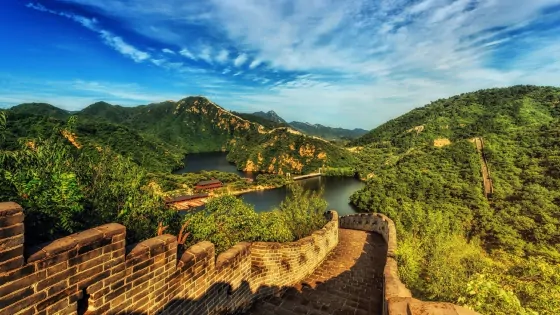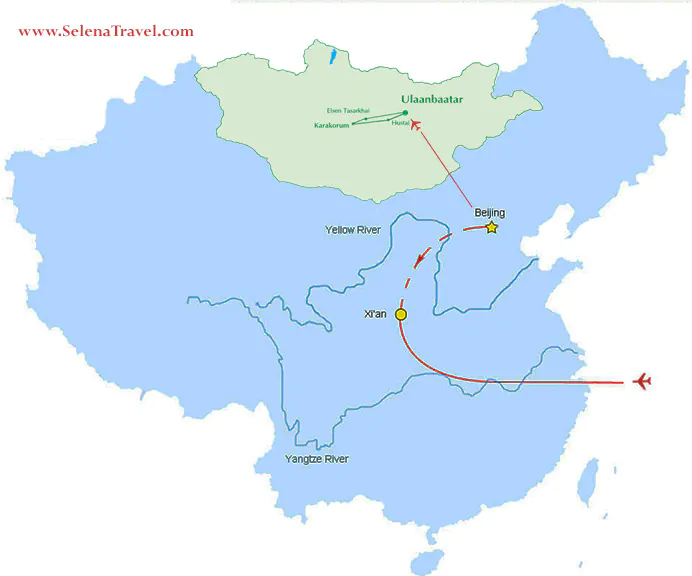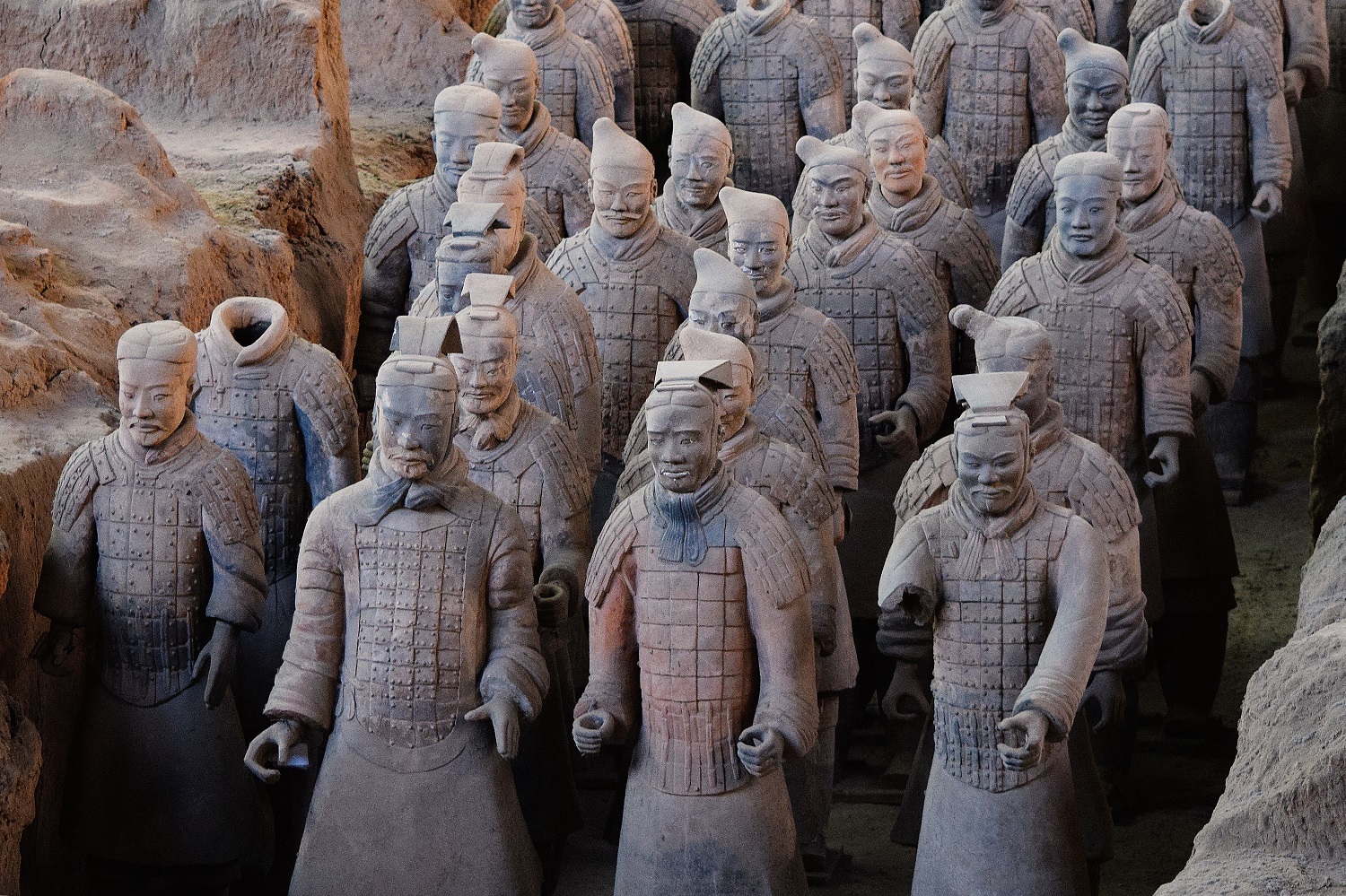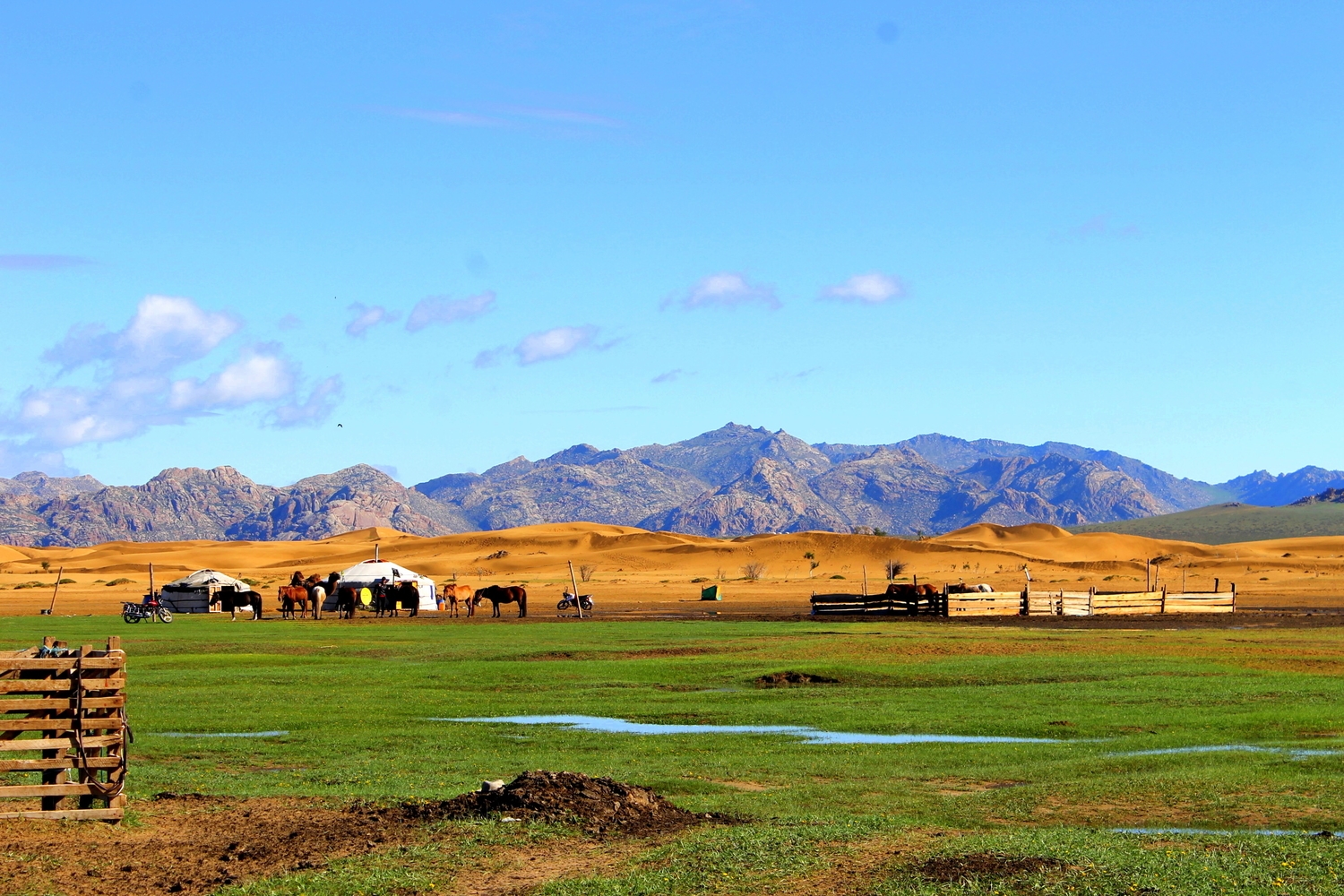

12days/11nights
Tour grade: Easy





Style: Private Tour
We invite you to travel China & Mongolia and explore its natural, historical and cultural wonders. You will visit Beijing, Xian - the most important 2 cities in Chinese history and Karakorum - ancient capital of Mongol Empires and admire the wonders. China has an ancient and abundant history that dates back more than 3000 years.
Beijing, an elegant modern city has been their capital for more than 800 year after Mongolian Khaan Khubilai made it the capital during the Mongols rule. Today Beijing has many historical memories like the Great Wall, Summer Palace, The Forbidden city and the famous Tiananmen square, where the hundreds of tragic students were killed in the late 20th century. Xi'an is another big place of the Chinese history. The Terracotta warriors, Wild Goose Pagoda, The Bell Tower and the Shaanxi Museum are considered the highlights of China as well.
In 1220 Genghis Khaan decided to move his capital from Khentii province to Karakorum, ~ 380 km southwest of modern day Ulaanbaatar. Permanent structure we only erected after Genghis death by his son Ogoodei Khaan. Karakorum served as the political, cultural and economic capital of the Mongols for only 40 years, before Khubilai Khaan moved in Kanbalik, in what is now Beijing. In the history modern Beijing was the Mongolian capital in the 14th century and now it’s not only a highly development city of China, but also one of most attractive tourist destination of the World. You will have very great chance to visit historical cities of Mongolia and China.





Arrival in Xi'an, China
Welcome to China!
Touch down in Xi'an and meet your guide for a one-hour private transfer to your downtown hotel.
Accommodation
Hotel 3-star
Meals Included
Sightseeing in Xi'an
The Terracotta Warriors make Xi'an famous around the world. Today, you will encounter this legendary army, which has guarded the first emperor of China, Qin Shihuang, since 210 B.C. Though had been buried underground for more than 2,200 years, these lifelike soldiers seem to tell you different stories through their vivid facial expressions.
After it, visit a Local Family including lunch. Visiting a local family should be a nice way to get a deeper understanding of Xi'an, especially in the aspects of their daily life and cuisine. You can communicate with the local family and learn how to make dumplings, hand-pulled noodles, and homely dishes.
Accommodation
Hotel 3-star
Meals Included
Full day tour Xi'an
Firstly, you will visit Big Wild Goose Pagoda which is a well-preserved ancient building and a holy place for Buddhists. This square-brick tower in pavilion type, by tower base, tower body, and tower top composition, is a good example of Chinese traditional architecture.
Followed by a visit to the Ancient City Walls and The Great Mosque of Xi'an, which is one of the four grand Islamic mosques in China with a history of more than 1,200 years.
Go to Gao's Courtyard, a well-preserved house of Ming and Qing dynasties, with a history of more than 400 years. Calligraphy experience at Gao's Courtyard.
After it, wander and pass through the Muslim Street, linked with shops selling a large variety of interesting local delicacies, snacks, and souvenirs. It is also packed with small restaurants serving typical Muslim food.
Accommodation
Hotel 3-star
Meals Included
Arrival in Beijing by high speed G train
In the morning, you'll be transferred to the station to board the high-speed train for Beijing. Your local private guide and driver will be waiting to greet you at the train station and take you to your hotel for a rest.
The Summer Palace, an imperial garden with lakes, artificial hills, and a broad range of ancient constructions, will be your destination after lunch. In beautiful weather, a boat trip on Kunming Lake is the perfect way to unwind.
Accommodation
Hotel 3-star
Meals Included
Beijing
Your tour today will begin at Tiananmen Square, a national icon that has witnessed many important historical and ceremonial events in China.
Walking through it, you will arrive at the Forbidden City, where Chinese emperors and their families lived for hundreds of years. By exploring the palaces and exhibits inside, you will learn the most well-known anecdotes about the ancient Chinese aristocracy and get a glimpse of China's long-gone imperial past.
This afternoon, make your way through Old Beijing's Hutongs. Enjoy a nostalgic rickshaw ride and Leisure Walking Tour in the Hutongs.
Accommodation
Hotel 3-star
Meals Included
Beijing
Start the tour today from the Temple of Heaven, where you will appreciate the elegance of the architecture itself and watch the locals doing morning exercises: playing Tai Chi, dancing with swords, and practicing Chinese calligraphy on the ground with a huge brush and water.
Afterwards, drive about two hours to visit the Great Wall (the less-crowded Mutianyu section). Get on the impressive ramparts with a cable car, hike up a little further to take in the imposing surroundings, and then descend by cable car again for the returning journey back to Beijing.
Accommodation
Hotel 3-star
Meals Included
Arrival in Ulaanbaatar, Mongolia
After breakfast, transfer to the airport for your flight to Ulaanbaatar, Mongolia.
Upon your arrival in Ulaanbaatar, our team will greet you at the airport after you’ve completed the necessary customs formalities. You’ll then be transported to your hotel for check-in. The remainder of the day is dedicated to allowing you to recover from any jet lag.
Accommodation
Hotel 4-star
Meals Included
Karakorum via Elsen Tasarkhai
Today, we will journey to Karakorum, the ancient capital of the Great Mongol Empire. The drive will take approximately 5– 6 hours, with a stop at Elsen Tasarkhai for lunch and a visit to a local nomadic family to experience their unique lifestyle. Here, we’ll also enjoy a one-hour camel ride across the picturesque dunes. We will arrive in Karakorum in the late afternoon, check into a ger camp, and settle in. Dinner and overnight at the camp.
Accommodation
Ger camp
Meals Included
Hustai National Park
After breakfast, we will visit the iconic Erdenezuu Monastery, the first Buddhist monastery established in central Mongolia in 1586. Then we will drive to Hustai National Park, a haven where the iconic Takhi wild horses roam freely alongside other captivating wildlife. Arrive there, we will head into the national park to spot the wild horse known as Takhi, birds and other wildlife. Enjoy one hour horse riding around in the evening. Dinner and overnight at a ger camp.
Accommodation
Ger camp
Meals Included
Terelj National Park
In the morning, we’ll drive to Terelj National Park, another delightful destination near the capital. On the way, we will stop at the Giant Genghis statue, which is the tallest equestrian statue in the world, and explore its surroundings. Arrive at the Terelj National Park and transfer to a ger camp. Then we will visit to Meditation Temple and Turtle rock (2-hour gentle hiking). Overnight at the ger camp.
Accommodation
Ger camp
Meals Included
Ulaanbaatar city tour
After breakfast, we will drive to Ulaanbaatar, then start a city tour /hotel check-in time is 2 pm/. Start with the National Museum of Mongolia, then lunch in a local restaurant. Then we will walk the Central Square of Mongolia named after Genghis Khan with 2 statues one dedicated to the Great Khan himself, and another to Sukhbaatar – hero of Mongolian people’s revolution in 1921. Optional souvenir shopping. As the day draws to a close, immerse yourself in Mongolia's rich cultural heritage with a traditional folklore concert. The day concludes with a heartfelt farewell dinner, a fitting way to celebrate the end of your journey.
Accommodation
Hotel 3-star
Meals Included
Departure from Ulaanbaatar, Mongolia
You will be transferred to the airport/train station after breakfast /or continue your post-tour to other parts of Mongolia/. Service Ends.
Meals Included
TOUR DATES
If you prefer a private tour experience, simply click the "Customize this tour" button located at the bottom of the page to personalize the itinerary according to your preferences. Upon submitting your request, our team of travel advisors will promptly provide you with a tailored proposal and quote.
TOUR PRICE
INCLUDED SERVICES
EXCLUDED SERVICES
SUPPLEMENT: EN-SUITE GER UPGRADE at the ger camps:
ACCOMMODATION INFO ON YOUR MONGOLIA TOURS:
In Ulaanbaatar: Ulaanbaatar, the capital of Mongolia, features a wide range of accommodations, from basic guesthouses to luxurious five-star hotels. Some of our tours do not include hotel stays in Ulaanbaatar, allowing you the flexibility to select a hotel that fits your needs and budget. Be sure to check the Inclusions and Exclusions section of your tour program to see if your hotel stay is part of the package. If you’d like assistance with booking, your travel consultant is ready to recommend and arrange the perfect hotel for your stay.
Here are hotels that we recommend:
- Springs hotel (3*)
- Holiday Inn (4*)
- Best Western Premier (5*)
- Shangri-La Hotel (5*)
Outside Ulaanbaatar: Outside of Ulaanbaatar where there are no hotels, tourist Ger (yurt) camps are the best accommodation for travelers. A Ger is Mongolian traditional dwelling made of felt layers and wooden construction, and the Mongolians have lived in Gers for thousands of years. Tourist Ger camps offer comfortable Gers with 1-3 beds with good bedding (1 Ger equals 1 hotel room), and also offer well-maintained public western style showers and WCs on their grounds. Some Ger camps offer en-suite bathroom facilities at additional charge, please ask your Selena Travel advisor for further details when booking your Mongolia tour.
MEALS ON SELENA TRAVEL TOURS:
In the capital city of Ulaanbaatar, a great variety of restaurants can be found and you will be eating at some of the best restaurants of Ulaanbaatar on your Mongolia tour while in the capital. Once you are outside the capital, Ger restaurants in Ger camps, local cafes in the small towns and sometimes nomadic families will be the places where you will be eating most of your meal. Ger restaurants often offer set continental breakfasts, set menu lunches and dinners consisting of salad or soup, main course and dessert.
While on the tour, during your longer driving days you will take packed lunch from Ger camps, often vegetable salad, main course such as fried chicken/noodles/dumplings and a small dessert, while hitting the road. Most of the food restrictions and allergies such as vegetarian, vegan, gluten free and many others, can be accommodated with ease on your Mongolia adventure.
The Karakorum was flourished in the IV-IX century by the Kirgis tribe and in 1220 the great Emperor Chinghis Khaan declared it as the capital city of his vast Empire. Many other Mongolian Khaans used Karakorum as the capital of Great Mongolian Empire, however, the Chinese Ming soldiers burnt the city several times in 15-17th century. Today there are many interesting sites left to visit; the legendary turtle rock sculptures, Buddhist stupas and the ruins of this once great city to name a few. This is one of the best place for Mongolian cultural tours.


by Rafaella, Benedetta, Lidia

by Margaret Suganda
Let us design that dream vacation for you